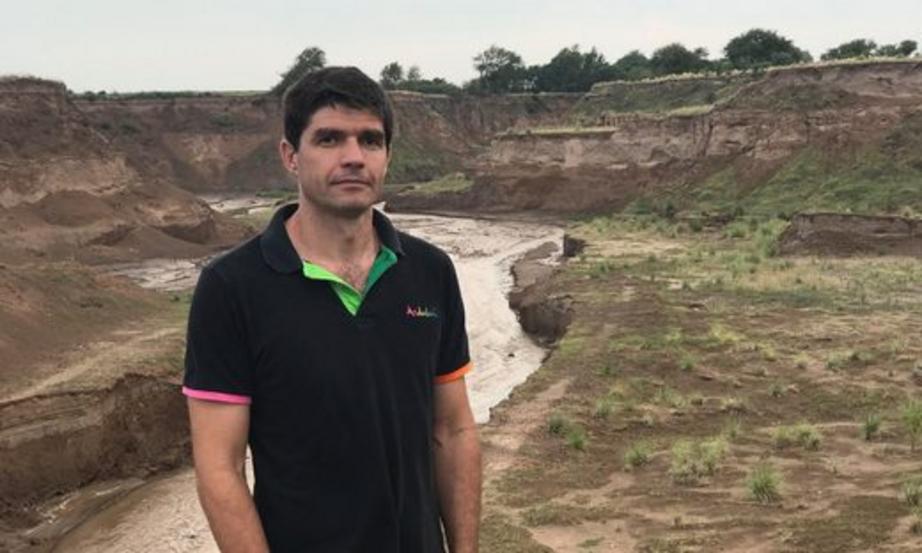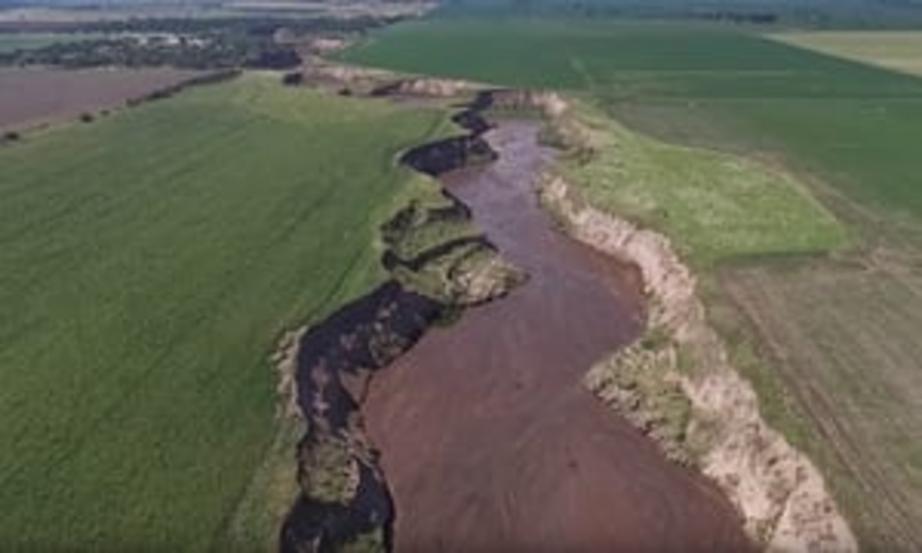When nature says 'Enough!': the river that appeared overnight in Argentina
A new watercourse is playing havoc with farmland and roads and even threatening a city – but also highlights the potential cost of the country’s dependence on soya beans
After a night of heavy rainfall, Ana Risatti woke to an ominous roar outside her home. Mistaking the noise for a continuation of the night’s downpour, she stepped outside to look.
“I nearly fainted when I saw what it really was,” said Risatti, 71. Instead of falling from the sky, the water she heard was rushing down a deep gully it had carved overnight just beyond the wire fence around her home.
The sudden appearance of a network of new rivers in Argentina’s central province of San Luis has puzzled scientists, worried environmentalists and disheartened farmers. It has also raised urgent questions over the environmental cost of Argentina’s dependence on soya beans, its main export crop.
 Alberto Panza: ‘This used to be totally flat pasture land.’ Photograph: Uki Goñi for the Guardian Advertisement Alberto Panza, a 41-year-old cattle
Alberto Panza: ‘This used to be totally flat pasture land.’ Photograph: Uki Goñi for the Guardian Advertisement Alberto Panza, a 41-year-old cattle
“The roar was terrifying,” said Risatti, remembering that morning three years ago. “The land had opened up like a canyon. Water was pushing through as far as I could see. Huge mounds of earth, grass and trees were being carried along the water surface.”
The ravine that carved its way so dramatically across Risatti’s farm that night has by now grown 15-miles (25km) long. At its deepest point, it measures more than 60 metres wide and 25 metres deep.
The largest of several new water courses, the Río Nuevo (New river) runs through Cuenca del Morro, a groundwater basin with a mild incline covering 373,000 hectares (nearly 1,500 sq miles) of flatlands in the province of San Luis.
Until the early 1990s, the Morro basin was a patchwork of water-absorbing forests and grasslands, but they are mostly gone, replaced by maize and soya beans.
Argentina’s transformation into a soya bean powerhouse has resulted in widespread deforestation to make way for the crop, which now covers of 60% of the country’s arable land. Some 2.4m hectares of native forest have been lost in the last 10 years, according to Greenpeace.
Esteban Jobbágy, an environmental expert at the University of San Luis, said the sudden appearance of new rivers was due to the convergence of three factors: “Number one, we have been going through rainy years in the recent past – climate has been changing. Next, the nature of the soils that we have here, which are quite unstable. And third, the fact that this watershed is hosting a lot of agriculture for the first time.”
Argentina is the world’s third largest soya bean producing nation, after the US and Brazil, and accounts for 18% of global production. In 2016, combined exports of soya beans, soya meal and soya bean oil made up 31% of the country’s total exports.
“Argentina is a banana republic where soya bean is the new banana,” says Jobbágy. “Without soya bean our farms couldn’t survive – and the country couldn’t survive either.
But unlike the deep-rooted forest it has replaced – which absorbed large amounts of groundwater all year round – soya bean has short roots and grows only a few months of the year.
This has caused the aquifer beneath the Morro basin to rise, and increased the speed of the subterranean flow – in turn triggering the collapse of the area’s permeable soil.
Around 2008, farmers started to report the appearance of shallow run-off channels, but in the last five years, the pace of the erosion quickened dramatically – and those streams have become deep trenches.
Climbing down the side of one of the new gullies, Jobbágy claws at the cliff wall and a clod of soil dissolves in his hand. “It’s basically dust,” he says.
“When it gets soaked, it becomes really unstable, and what looks like a solid becomes a liquid. [So] this humble river moves a lot of sediment despite the relatively gentle incline,” Jobbágy explains.
That leads to a second problem for farmers: sometimes entire fields downstream can disappear overnight when rivers dump layers of sediment up to a metre (3ft) thick.
Alberto Panza, a 41-year-old cattle rancher, is one of the few holdouts refusing to lease his land to the giant soya-bean conglomerates that have largely replaced Argentina’s small farmers.
Driving his battered pick-up truck along a dirt road, Panza remarks on how deserted the land looks today: no longer are there any gauchos – Argentina’s cowboys – riding bareback through the fields. Farmhouses have been demolished to open up additional land to lease to soya producers.
“Many farmers now live in the city,” says Panza. “It’s easier to move out and lease your land to a company than to farm it yourself.”
Arriving at his ranch, Panza walks into what can only be described as a Martian landscape. In the middle of a field, a giant canyon more than 60 metres wide and 25 metres deep drops abruptly away, a deceptively slow current of water at the bottom.
Panza’s farm was cut in two by the canyon. “This used to be totally flat pasture land,” he says. A tall electricity pole lies on its side on the river bed, its cables still attached to poles standing on the other side.
Because the river keeps changing course, Panza has been unable to build a bridge or a path through the waters to reach the other side of his land.
With less than one third of the Morro basin left covered in forest or grasslands – and nearly half devoted to soya and maize – the government of San Luis has finally stepped in to try to save the basin from becoming a river delta.
For the rest of this article please go to source link below.
Video can be accessed at source link below.

